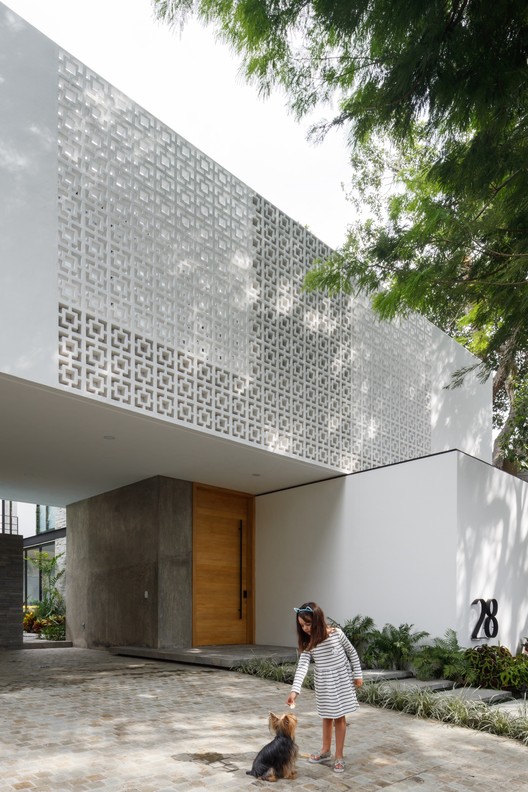The Zig Zag Building Lynch Architects
2016-12-19 05:00
© Tim Soar
{\f25TIM}{\f6({\f25


架构师提供的文本描述。ZigZag大楼取代了20世纪50年代在伦敦市中心维多利亚街的办公大楼,靠近议会大厦和白金汉宫,拥有堪称典范的新办公空间。在不同的尺度上,柱廊指示和定义在我们项目范围更广的范围内的各种不同类型住房的入口,例如办公室、住房、餐馆、商店、酒吧等。该设计位于大教堂和市政厅之间,旨在从规模和规模两方面进行协调,并建立一个可靠而令人愉悦的城市空间秩序,将威斯敏斯特这一地区的粮食连接起来。
Text description provided by the architects. The Zig Zag Building replaces a 1950s office block on Victoria Street in central London, close to The Houses of Parliament and Buckingham Palace, with exemplary new office space. Colonnades at various scales indicate and define the entrances to the various different types of accommodation housed within the broader scope of our project e.g. offices, housing, restaurants, shops, bars, etc. Situated between a cathedral and a town hall, the design seeks to mediate between these two in terms of size and scale and to establish a credible and pleasurable urban spatial order connecting together the grain of this part of Westminster.


建筑内外之间的关系被作为一系列的门槛来表达,这些门限是经过仔细校准的、阴影的、可打开的、但大多是透明的外观,但从远处看却是坚实的。层层遮阳不仅增加了海拔的比例,而且也因不同的方向而异,给居住者提供了享受新鲜空气和自然光的可能性-以及对自然资源的良性保护。
The relationships between the inside and outside of the building are articulated as a series of thresholds in carefully calibrated, shaded, open-able, yet mostly transparent façades that nonetheless appear solid from afar. Layers of shading not only add scale to the elevations, but also vary across the different orientations, offering occupants the possibility of the enjoyment of fresh air and natural light - along with the virtuous preservation of natural resources.
© David Grandorge
(David Grandorge)


在较高层,在一楼和一楼的零售宿舍之上,办公室外墙有六个主要组成部分。第一种是内部结构柱,它是最小直径的圆形结构柱。
On the upper levels, above the retail accommodation at ground and first floor, the office facade has six principal components. The first is the internal structural columns, which are circular with minimal diameter.
© David Grandorge
(David Grandorge)


这避免了与第二个元素,幕墙的尴尬关系,幕墙C31阳极化淡青铜色稳定门风格的开放面板安装在1.5米的网格和3米的面板上。至少2.5%的办公面积必须是可打开的外墙,以使消防队能够在火灾后清除烟雾,并且大约同样的比例需要隔热。我们把这两个参数结合在一起,创造了一个百叶窗,使交叉通风,并形成一个朱丽叶阳台,当完全打开。立面总体上与建筑的能源战略并行不悖。
This avoids an awkward relationship with the second element, the curtain wall, which has C31 anodized pale bronze-coloured stable-door style openable panels set up on a 1.5m grid and 3m panel. At least 2.5% of an office floor area must be openable façade to enable the fire brigade to purge smoke after a fire, and around the same proportion needs to be insulated. We have combined these two parameters to create a shutter that enables cross ventilation and which forms a Juliette balcony when fully opened. The façade works in tandem with the energy strategy for the building generally.


© Rory Allen
罗里·艾伦


Detail Sketch


混凝土楼板的毛细冷却,再加上冷却梁,创造了省略传统吊顶的可能性,从而产生了地板到天花板的高度超过3.3米的可能性。在幕墙前,由一个50毫米的缝隙隔开的是第三个元件,厚度为3.7米x65毫米的不同深度的阳极化翅片,它遮住了东西部的太阳增益的正面。在最低层,鳍设置在1.5米中心,深600毫米,在连续地板上的宽度和深度逐渐减小,即当它们靠近时,投出更多的阴影,因此它们的深度相应地减小,以保存材料。这会使建筑物显得更高、更有风貌。
Capillary cooling in the concrete floor slab, combined with chilled beams, creates the possibility of omitting a conventional suspended ceiling, thus creating a floor-to-ceiling height of over 3.3m. In front of the curtain wall, and separated by a 50mm gap, are the third element, 3.7m x 65mm thick anodized fins of varying depths, that shade the façade from solar gain from the east and west. At the lowest level, the fins are set at 1.5m centres and are 600mm deep, gradually diminishing in width and depth on successive floors i.e. as they get closer together they cast more shadow, and thus their depth reduces accordingly to conserve materials. This has the effect of making the building appear taller and more statuesque.
© Tim Soar
{\f25TIM}{\f6({\f25


第四个元素是水平Cill,它从南部中午的夏季阳光中遮蔽立面,并且在整个过程中保持不变的深度。第五元件是悬挂的半透明玻璃,"多利"从太阳的增益和由春天和秋季的太阳所引起的眩光中保护FA1ADE,这在中午并不在天顶,但通常是强烈的。该装置由层压玻璃构成,该层压玻璃具有描绘了Onyx的各种图像的印刷层间层。最后,建筑的“曲折之字形”几何形状夸大了光线和阴影在FAUade上的播放,这种多样性是由在温暖的日子里居住者开放的不同部分所做的图案来补充的。
The fourth element is the horizontal cill that shades the facade from the south midday summer sun and which remains a constant depth throughout. The fifth element is a hanging translucent glass ‘doily’ protects the façade from solar gain and glare arising from spring and autumn midday sun, which is not quite at the zenith at noon but nonetheless often intense. The doily is made up of laminated glass with a printed inter-layer depicting a variety of images of onyx. Finally, the “zigzag” geometry of the building exaggerates the play of light and shadow across the façade, and this variety is complimented by patterns made as occupants open different parts of it on warm days.


半透明的小报记录了另一层居住,并对季节和白天的时间作出反应,因为在冬季,它们开始在工作日结束时发光。梯田种植树木和鲜花,进一步强调在居民的工作生活中自然世界的存在。在沃格特的景观设计中,对居民福祉的关注是平衡的,反映在布列斯-卢森堡和蒂莫西·贝斯的艺术作品中。ZigZag大楼是预出租给德意志银行和木星资产管理公司.该项目于2016年11月在柏林举行的世界建筑节上获得了最佳办公建筑奖。
The translucent doilies register another layer of inhabitation and respond to seasonal and diurnal time, as, in the winter months, they begin to glow towards the end of the working day. Terraces are planted with trees and flowers, emphasizing still further the presence of the natural world within the working lives of the inhabitants. Concern for the well-being of inhabitants is balanced by the care taken in the design of the landscape by Vogt, and is reflected in the art works of Rut Blees-Luxemburg and Timorous Beasties. The Zig Zag Building was pre-let to Deutsche Bank and to Jupiter Asset Management. The project won the Best Office Building award at The World Architecture Festival, held in Berlin in November 2016.
© David Grandorge
(David Grandorge)




































































































































































Architects Lynch Architects
Location 70 Victoria St, Westminster, London SW1E 6SQ, UK
Category Store
Design Team Patrick Lynch, Claudia Lynch, David Evans
Area 3500.0 m2
Project Year 2016
Photographs Hufton and Crow, David Grandorge, Tim Soar, Sue Barr, Rory Allen, Tom Lee , Tom Roreby, Nikita Shergil
Manufacturers Loading...































